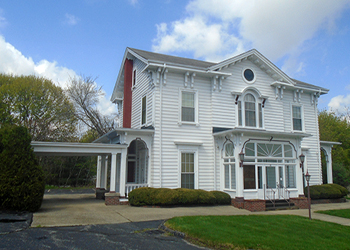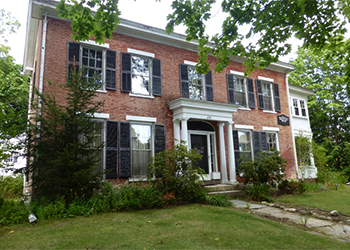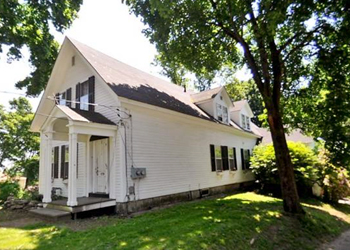The Worcester Historical Commission, under MGL Chapter 40C, has voted to study the possible creation of a local historical district (LHD) for each of the following properties and neighborhoods.
The preliminary study is a formal process to gather information on the property or group of properties under consideration, engage in dialog with neighborhood residents, property owners and the public at large and develop a recommendation on the potential formation of a new local historic district for further consideration (or not) by City Council. After the Worcester Historical Commission makes a recommendation, the creation of any new local historic district is determined by a vote of the City Council following receipt of the Commission's final study report on the potential local historic district.
Ransom C. & Mary L. Taylor Estate - 36 Butler Street

The Ransom C. & Mary L. Taylor Estate is a historic house at 36 Butler Street. Built in 1858 as a country house for Ransom Clark Taylor and designed by Mechanic's Hall Architect Elbridge Boyden, it is one of the City's finest surviving examples of Italianate architecture. It was listed on the National Register of Historic Places in 1980.
Liberty Farm - 116 Mower Street
Designated as one of only two National Historic Landmarks in Worcester in 1974, Liberty Farm, constructed in the Federal style about 1810, is significant for its association with abolitionist and women's rights advocate Abby Kelley Foster. She and her husband, Stephen Symonds Foster, lived on the farm from 1847 until 1881.
Please provide your feedback on the creation of the Liberty Farm Local Historic District - Online Survey. The survey will close on April 4, 2025.

Robert Hutchings Goddard Birthplace - 1 Tallawanda Drive

The Robert Hutchings Goddard Birthplace at One Tallawanda Drive was constructed about 1835, likely in a vernacular interpretation of the Greek Revival Style and was remodeled to its current appearance in the late 1920s. At the time of Goddard's birth in a second-floor bedroom of the house on October 5, 1882, the homestead was called Maple Hill.
Hammond Heights Neighborhood
On February 29, 2024, the Historical Commission decided to study this historic neighborhood, recognizing its architectural significance and contribution to the City's heritage. The Hammond Heights neighborhood, a well-preserved enclave of single-family homes, many of which were architect-designed, holds a significant place in Worcester's history. Developed during the late 19th to early 20th century, Hammond Heights is an historic neighborhood sited on a hillside site between Highland Street and Institute Road. Prior to 1890, the area was part of the John Hammond Farm, although plans for its subdivision had been laid out before 1886. The original subdivision plan created Germania (now Germain) Street, Buffalo (now Haviland) Street and Genesee (now Westland) Street. Construction in the area began in between 1890 and 1896, with sixteen houses built along Germain and Highland Streets. By 1911, an additional 40 houses had been built along Westland and Haviland Streets. Architecturally, the neighborhood showcases a range of styles popular during the middle and upper-middle-class suburbanization of Worcester's West Side. The eclectic mix of architectural styles seen in the houses in Hammond Heights reflect the diverse tastes of their original owners. Examples include the former home of John Hammond, an excellent example of the Italianate style and several exceptional Queen Anne-style residences along Germain Street. The well-preserved condition of most houses, coupled with tree-lined streets and expansive lawns, makes Hammond Heights a prime example of Worcester's development during the early 20th century.
Study Process
The studies will be conducted during 2024 by the Worcester Historical Commission, assisted by staff from the Planning & Regulatory Services Division. The study will include the following steps.
Assess Architectural and Historic Significance
The Committee will assess the architectural and historical significance of the general environs and the buildings within the proposed district.
Neighborhood Opinion Survey
To gauge community interest and support for the proposal, as well as inform potential components and governing rules, a neighborhood-wide opinion survey will be conducted.
Preliminary Study Report
The study findings will be documented in a Preliminary Study Report, which will be accepted by a vote of the Worcester Historical Commission, released for public review and submitted to the Massachusetts Historical Commission (MHC) and Worcester Planning Board for comments.
Public Hearing
A public hearing regarding the proposed LHD, held by the Worcester Historical Commission, will take place no less than 60 days after the report is deemed complete by the MHC.
Committee Recommendation
Following the public hearing, the Worcester Historical Commission will make a recommendation for consideration by the City Council. The City Council will then determine whether to establish a new Local Historic District, its boundaries and its governing rules.
Additional Information
Additional information and opportunities to participate will be posted to this webpage as the studies progress. Community members wishing to share information about the properties under study are welcome and encouraged to contact our office.
Staff Contact:
Michelle Johnstone, Senior Preservation Planner
508-799-1400 x31440
Have a Question?
Many properties in proposed local historic districts are listed in the National Register of Historic Places or are inventoried with the Massachusetts Historical Commission. These designations offer only minimal protection and are honorary in nature. Some houses have no protection at all. By creating a local historic district, the historic character of the building(s) in a local historic district will be much better protected. The difference between a National Register of Historic Places and Local Historic District designation is detailed by the Massachusetts Historical Commission: There’s a Difference!
Before acquiring a building permit for your project, you will fill out an application for review by the Worcester Historical Commission. The Commission will then hold a public hearing and review the proposed project plans to make sure that they are appropriate changes to the historic district. If the project is appropriate, the Worcester Historical Commission will issue a Certificate of Appropriateness. You will then include the Certificate of Appropriateness with your building permit application. If the project is not found appropriate, then the Commission may explain to you how the project could be improved in order to be approved.
No, you can maintain the current look of your house as long as you would like. A local historic district only reviews proposed changes to exterior architectural features visible from the public way. Routine maintenance is also exempt from review.
By having a local historic district, you can be assured that a NEW property owner across the street from your house will also maintain the historic character of the neighborhood.
City staff and the Worcester Historical Commission are happy to work with homeowners to find creative solutions that are financially feasible without compromising the architectural integrity of our historic resources. In cases where there is a bona fide hardship, a Certificate of Hardship may be issued in lieu of a traditional Certificate of Appropriateness.
Exterior architectural features visible from a public way will be reviewed, with some exceptions which are detailed in the proposed bylaw for any proposed local historic district. Interior changes, landscaping, maintenance and exterior features not visible from a public way are not reviewed.
No one can predict the future, but studies around the country suggest that property values stay the same or increase faster in local historic districts compared to similar, non-designated areas.
Contact Information
Address
Planning & Regulatory Services
City Hall Room 404
455 Main Street
Worcester, MA 01608
Contact
Phone: 508-799-1400
Fax: 508-799-1406
Email Us
![]()
Hours
Monday - Friday
8:30 a.m. - 5 p.m.

